“Vaginal oestrogen is a hormone replacement therapy (HRT)
medicine that contains the hormone oestrogen.
It’s used to treat the vaginal dryness and irritation…”.1
Umbrella
What may the Hormone Therapy and Vaginal Estrogen Umbrella include?
Depending on the Source (DotS) this Umbrella may include:
- Hormone Replacement Therapy (HRT)
- Hormone Therapy (HT)
- Local Low-Dose Estrogen Therapy
- Menopausal Hormone Therapy (MHT)
- Topical Vaginal Estrogens
- Vaginal Estrogen/Oestrogen
Position Statement
When may vaginal estrogen be recommended?
On page one in The 2022 Hormone Therapy Position Statement of The North American Menopause Society: Abstract, published July 2022, the North American Menopause Society (NAMS) note:
“For bothersome genitourinary syndrome of menopause symptoms not relieved with over-the-counter therapies in women without indications for use of systemic hormone therapy, low-dose vaginal estrogen therapy or other therapies (eg, vaginal dehydroepiandrosterone or oral ospemifene) are recommended”.2
Vaginal Estrogen
What is vaginal estrogen?
DotS the definition of vaginal oestrogen may vary. In Hormone Replacement Therapy (HRT): Vaginal Oestrogen: About Vaginal Oestrogen the NHS definition is:
“Vaginal oestrogen is a hormone replacement therapy (HRT) medicine that contains the hormone oestrogen. It’s used to treat the vaginal dryness and irritation that can happen during the menopause”.3
On page one in Deciding About Hormone Therapy the NAMS explain:
““If you are bothered only by vaginal dryness, you can use very low doses of estrogen placed directly into the vagina. These low doses generally do not raise blood estrogen levels above postmenopause levels and do not treat hot flashes. You do not need to take a progestogen when using only low doses of estrogen in the vagina. (The MenoNote “Vaginal Dryness” covers this topic in detail)”.4
In The 2023 Practitioner’s Toolkit for Managing Menopause: Management – Effectiveness: Local Treatment of Urogenital Atrophy, published online 30 October 2023, the authors note:
Cream, Tablet, Pessary or Ring
How can estrogen be applied directly to the vagina?
In Vulvovaginal Atrophy: Topical Vaginal Estrogens the European Menopause and Andropause Society explain:

- “These may contain estradiol, estriol, promestriene and conjugated estrogens
- Preparations include tablets, rings, capsules, creams, gels and ovules
- Most are low-dose and do not change systemic estrogen levels
- There is no need to add progestogen (for endometrial protection) when low-dose topical estrogens are used
- They can be used alone or with systemic menopausal hormone therapy
- They may also improve urinary incontinence and prevent recurrent urinary tract infections
- They do not increase the risk of endometrial cancer, breast cancer, venous thromboembolism or cardiovascular disease”.6
Duration
How long can vaginal estrogen be used for?
On page three and four in the Joint Position Statement By the British Menopause Society, Royal College of Obstetricians and Gynaecologists and Society for Endocrinology on Best Practice Recommendations for the Care of Women Experiencing the Menopause, first published online 10 June 2022, one of the recommendations is:

- “Low-dose and ultra-low dose vaginal oestrogen preparations can be taken by perimenopausal and menopausal women experiencing genitourinary symptoms and continued for as long as required. All vaginal oestrogen preparations have been shown to be effective in this context and there is no requirement to combine vaginal oestrogens with systemic progestogen treatment for endometrial protection, as low-dose and ultra-low dose vaginal oestrogen preparations do not result in significant systemic absorption or endometrial hyperplasia”.7
Compounded Vaginal Estrogen and Testosterone
Are compounded vaginal estrogen and testosterone recommended?
On page two in Vaginal Dryness the (United States) Menopause Society [formerly The North American Menopause Society) include:
What is FDA?
FDA in the context above, is an abbreviation for the (United States) Food and Drug Administration.
What is GSM?
GSM in this context, is an abbreviation for the Genitourinary Syndrome of Menopause.
Health Care Provider
What if my vaginal symptoms do not improve with treatment?
On page two in Vaginal Dryness the Menopause Society explain:
Health Topics A-Z
Where may I find Health Topics A-Z related to Hormone Therapy and Vaginal Estrogen?
In Health Topics A-you may find:
Links
Where may I find Links related to Hormone Therapy and Vaginal Estrogen?
Your Country may have Links similar to:
Links
This Links List to third party websites is neither comprehensive nor exhaustive. Inclusion on this Links List does not imply endorsement or recommendation. Non-inclusion on this Links List does not imply non-endorsement or non-recommendation. Third party websites are not under the control of Meno Martha International Menopause Directory. Third party websites may contain explicit medical images and/or sexual references. Please read Meno Martha International Menopause Directory’s Links Policy before proceeding to a Link. Please contact Webmaster if you experience a problem with a Link.New or Updated
- HRT Questions Answered [04 October 2024]
- Menopause and Hormone Therapy: Current Perspectives and Controversies [18 October 2024]
- What Types of Vaginal Oestrogens Are There?
- Which Vaginal Moisturiser Should You Use?
- World Menopause Day [18 October 2024]: Leaflet for Women [Multiply Languages]
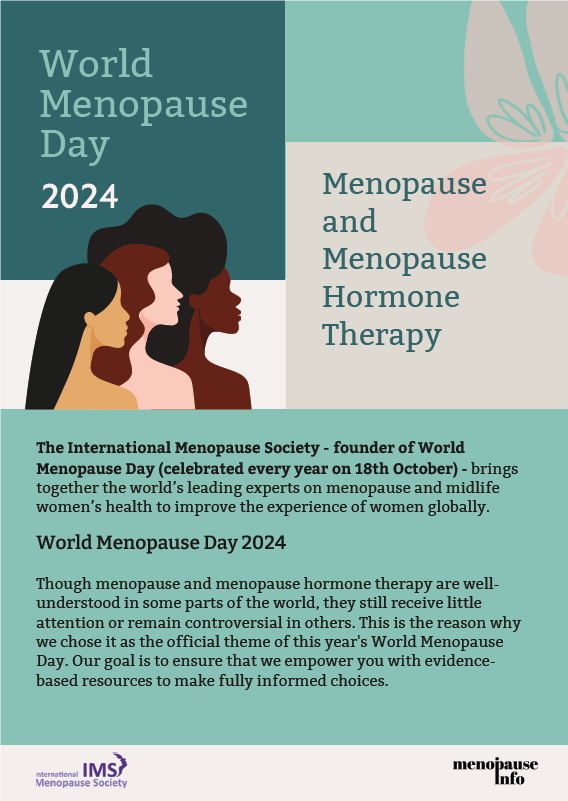
- World Menopause Day [18 October 2024]: Poster for Women
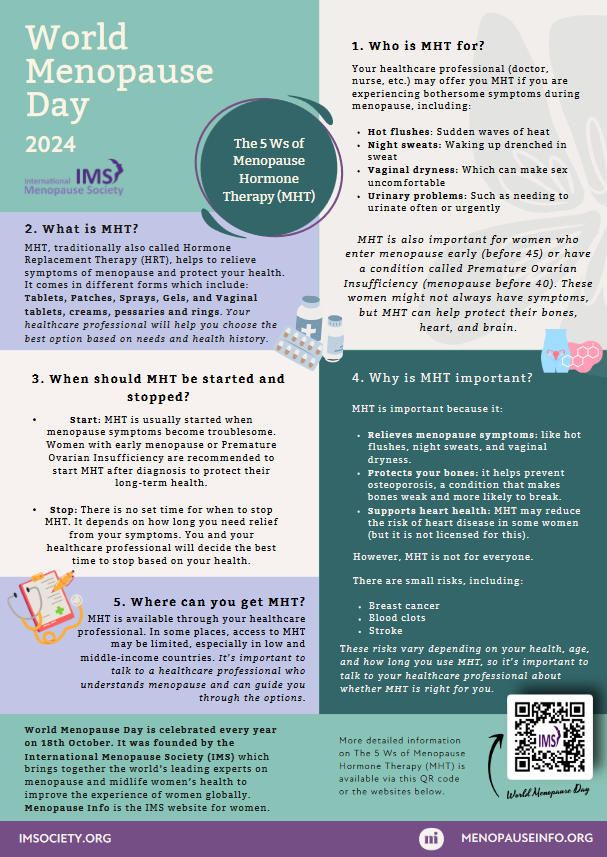
- BMS TV: Bioidentical Hormones
- BMS TV: Hormone Replacement Therapy (HRT)
- BMS TV: Urogenital Atrophy
- BMS TV: Testosterone Explained
- Bioidentical Hormones: Are They Safer?
- Caredownthere
- Consumer Video and Podcast Series: 2022 Consumer Videos and Podcasts – Hormone Therapy: Understanding the Risks and Benefits
- Consumer Video and Podcast Series: 2022 Consumer Videos and Podcasts – Perimenopause, Signs, Symptoms, and Solutions
- Consumer Video and Podcast Series: 2024 Consumer Videos and Podcasts – Preparing for Your Menopause Health Care Visit
- Deciding About Hormone Therapy
- Deciding About Hormone Therapy Use
- Easier Access To Locally Applied HRT To Treat Postmenopausal Vaginal Symptoms In Landmark MHRA Reclassification [British Menopause Society]
- Endometrial Safety of Low-Dose Vaginal Estrogens
- Endometrial Safety of Low-Dose Vaginal Estrogens [Video]
- Estradiol Vaginal Cream
- Estrogen (Vaginal Route): Before Using
- Estrogen (Vaginal Route): Description and Brand Names
- Estrogen (Vaginal Route): Precautions
- Estrogen (Vaginal Route): Proper Use
- Estrogen (Vaginal Route): Side Effects
- Experiencing Vaginal Dryness? Here’s What You Need To Know
- Genitourinary Syndrome of Menopause
- HRT Questions Answered
- HRT – Types, Doses and Regimens
- Hormonal Treatments and Vaginal Moisturizers for Genitourinary Syndrome of Menopause: A Systematic Review
- Hormone Replacement Therapy (HRT): Benefits and Risks of Hormone Replacement Therapy (HRT)
- Hormone Replacement Therapy (HRT): Vaginal Oestrogen
- Hormone Replacement Therapy (HRT): Vaginal Oestrogen – About Vaginal Oestrogen
- Hormone Replacement Therapy (HRT): Vaginal Oestrogen – Common Questions About Vaginal Oestrogen
- Hormone Replacement Therapy (HRT): Vaginal Oestrogen – How and When To Use Vaginal Oestrogen
- Hormone Replacement Therapy (HRT): Vaginal Oestrogen – Side Effects of Vaginal Estrogen
- Hormone Replacement Therapy (HRT): Vaginal Oestrogen – Using Vaginal Oestrogen With Other Medicines and Herbal Supplements
- Hormone Replacement Therapy (HRT): Vaginal Oestrogen – Who Can and Cannot Use Vaginal Oestrogen
- Hormone Therapy: Is It Right for You?
- International Society for the Study of Women’s Sexual Health: Find A Provider
- Joint Position Statement By the British Menopause Society, Royal College of Obstetricians and Gynaecologists and Society for Endocrinology on Best Practice Recommendations for the Care of Women Experiencing the Menopause
- Later Years (Around 50 Years and Over): Menopause and Post Menopause Health – Hormone Replacement Therapy (HRT) [+ Video: Is HRT Bad for You?] [Other Languages and Formats]
- Later Years (Around 50 Years and Over): Menopause and Post Menopause Health – Sexual Wellbeing, Intimacy and Menopause [+ Video: Menopause Is the End of Your Sex Life] [Other Languages and Formats]
- Later Years (Around 50 Years and Over): Menopause and Post Menopause Health – Supporting Someone Through the Menopause [+ Video: Men Don’t Need To Know About Menopause] [Other Languages and Formats]
- Let’s Talk About Perimenopause
- Looking After Yourself: Sex and Relationships
- Lubricant Alternatives: What To Use and What To Avoid
- Managing Your Symptoms: Managing Bladder, Vaginal and Vulval Problems
- Menopause
- Menopause
- Menopause Map: Downloadable Resources – My Personal Path Print Tools – Questions for Your Health Care Provider
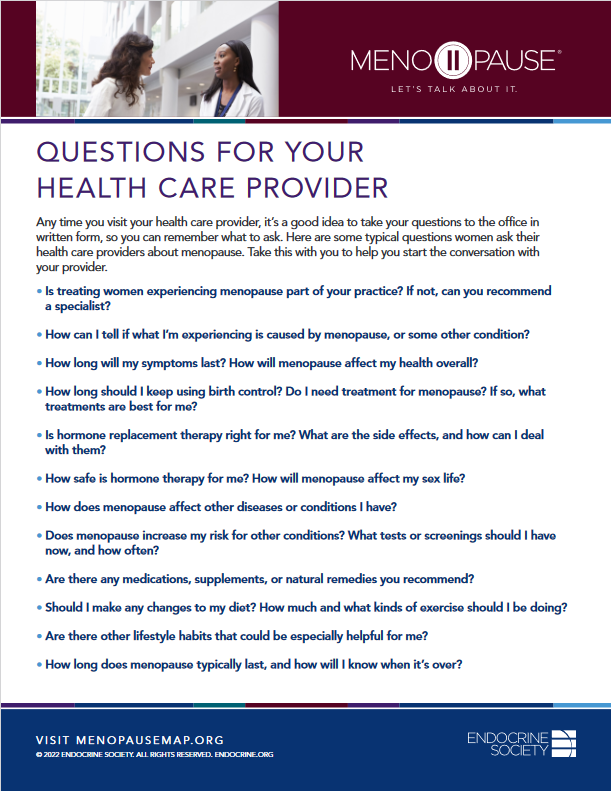
- Menopause Patient Information [Videos] 2. Talking To Your GP About Menopause
- Menopause Patient Information [Videos] 4. The Different Types of HRT
- Menopause Preparedness Toolkit Video Series: Common Conditions Associated With Menopause and Midlife
- Menopause Preparedness Toolkit: A Woman’s Empowerment Guide
- Menopause Ruining Your Sex Life?
- Menopause Symptoms: Mayo Clinic Expert Outlines Hormone and Nonhormonal Therapies
- Menopause Treatments: What Works, What Doesn’t – Treatments for Vaginal Dryness
- Menopause and HRT
- Menopause and Hormone Therapy: Current Perspectives and Controversies
- Menopause: Diagnosis and Management – Information for the Public: Questions To Ask About Menopause [NICE Guideline]
- Menopause: Menopause – Hormone Treatments
- Menopause: Things You Can Do
- Menopause: Understanding the Changes and Finding Relief | Dr Susan Davis | The Proof Podcast EP 256
- Mymenoplan.org [My Menoplan, United States]
- Natural Remedies To Help Manage Perimenopause Symptoms
- Navigating Menopause Together: How Partners Can Help
- Navigating Menopause: Expert Insights and Solutions | Dr Susan Davis | The Proof Podcast EP 245
- Need Reliable and Accurate Information About the Menopause and HRT? Watch This!
- Perimenopause and Menopause Checklist: Translated Checklists
- Perimenopause and Menopause Symptom Checklist
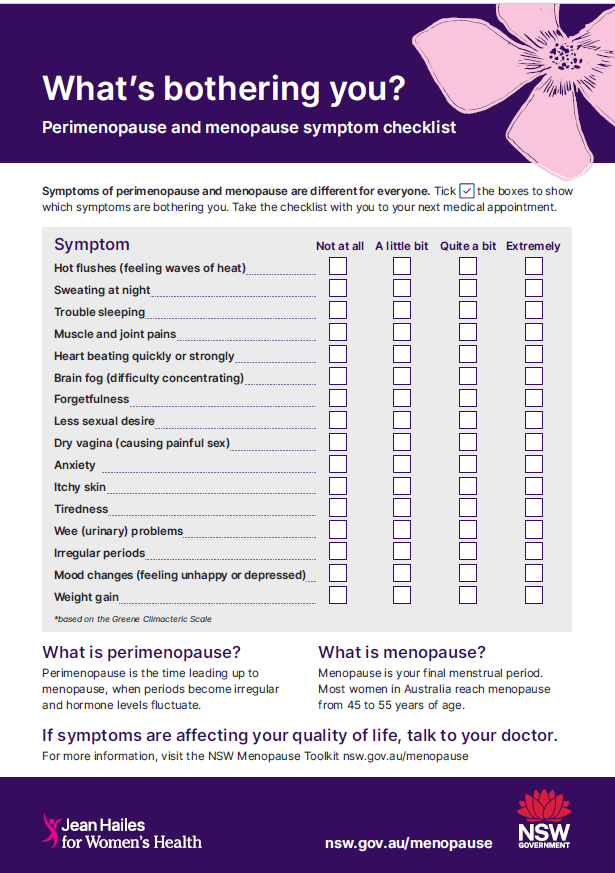
- Position Statement for Management of Genitourinary Syndrome of the Menopause (GSM)
- Prosayla Supported By ISSWSH [International Society for the Study of Women’s Sexual Health]
- Risks and Benefits of MHT
- Shedding Light on the Menopause Experience and Demystifying Treatment
- Sheplusfoundation.com [She+ Foundation [formerly The Patty Brisben Foundation of Women’s Sexual Health]]
- Supporting A Loved One Through Menopause
- The Menopause Society Statement on Misinformation Surrounding Hormone Therapy [September 2024]
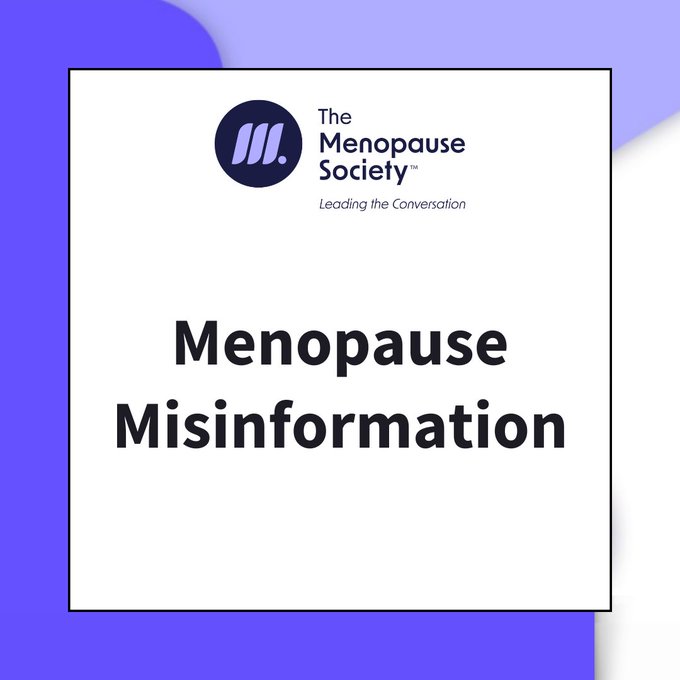
- The North American Menopause Society Releases Its 2022 Hormone Therapy Position Statement
- Therapy for the Effects of Menopause
- Tips To Help Manage Menopause Symptoms
- Topical Estrogens and Non-Hormonal Preparations for Postmenopausal Vulvovaginal Atrophy: An EMAS Clinical Guide
- Urogenital Problems
- Urologic View In the Management of Genitourinary Syndrome of Menopause
- Using Natural Therapies In the Menopause Transition – Webinar
- Vaginal Atrophy
- Vaginal Dryness
- Vaginal Dryness
- Vaginal Dryness
- Vaginal Dryness After Menopause: How To Treat It? I’m postmenopausal and often have vaginal dryness, which makes intercourse painful. Is there anything I can do about it?
- Vaginal Dryness Alternative Treatments
- Vaginal Dryness: Treatment Options
- Vaginal Dryness: What To Do About It
- Vaginal Estrogen
- Vaginal Laser Therapy for GSM/VVA: Where We Stand Now – A Review By the EUGA Working Group on Laser
- Videos and Podcasts: Videos – Interviews: Vulvovaginal Atrophy
- Vulva and Vaginal Health: Getting the Right Advice
- Vulvovaginal Atrophy
- Vulvovaginal Health
- Webinars: Previous – Genitourinary Syndrome of Menopause
- Webinars: Previous – Pay Attention on Your Way In! The Vulva Is An Important Organ Too
- Why Didn’t Anyone Tell Me This? Episode 3: Dr Annice Mukherjee: Your Essential Menopause Toolkit
- Wild Yam
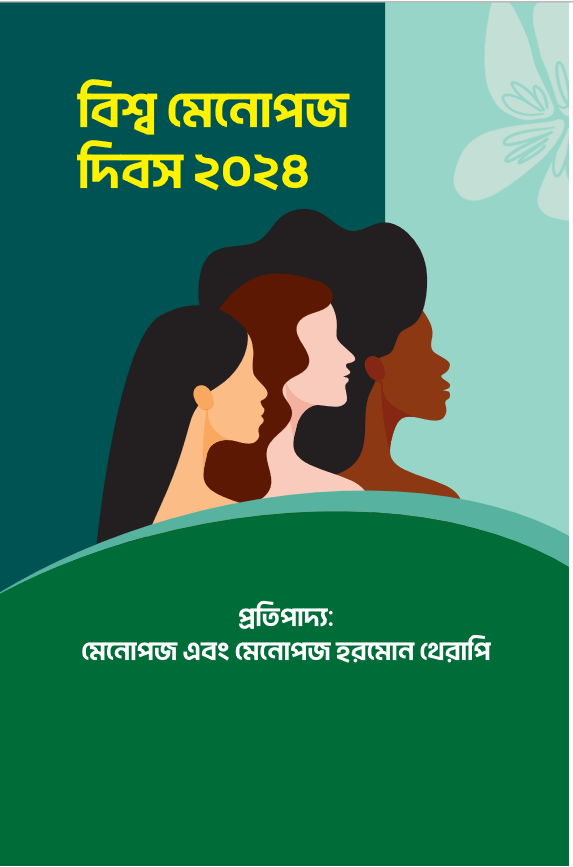 World Menopause Day [18 October 2024]: Leaflet for Women [Multiply Languages]
World Menopause Day [18 October 2024]: Leaflet for Women [Multiply Languages]- World Menopause Day [18 October 2024]: Poster for Women
Sources
Where may I find the Sources quoted?
You may find the Sources quoted at:
Sources
- Hormone Replacement Therapy (HRT): Vaginal Oestrogen: About Vaginal Oestrogen. Page Last Reviewed: 27 January 2023. NHS https://www.nhs.uk/medicines/hormone-replacement-therapy-hrt/vaginal-oestrogen/about-vaginal-oestrogen/ Accessed: 18 October 2024
- The 2022 Hormone Therapy Position Statement of The North American Menopause Society: Abstract. 2022:1 North American Menopause Society https://www.menopause.org/docs/default-source/professional/nams-2022-hormone-therapy-position-statement.pdf Accessed: 18 October 2024
- Hormone Replacement Therapy (HRT): Vaginal Oestrogen: About Vaginal Oestrogen. Page Last Reviewed: 27 January 2023. NHS https://www.nhs.uk/medicines/hormone-replacement-therapy-hrt/vaginal-oestrogen/about-vaginal-oestrogen/ Accessed: 18 October 2024
- Deciding About Hormone Therapy Use. 2022:1. North American Menopause Society https://www.menopause.org/docs/default-source/professional/menonote-deciding-about-ht-2022.pdf Accessed: 18 October 2024
- Davis, S. R., Taylor, S., Hemachandra, C., Magraith, K., Ebeling, P. R., Jane, F., and Islam, R. M. The 2023 Practitioner’s Toolkit for Managing Menopause: Management – Effectiveness: Local Treatment of Urogenital Atrophy. First Published Online 30 October 2023 https://www.tandfonline.com/doi/full/10.1080/13697137.2023.2258783 Accessed: 18 October 2024
- Vulvovaginal Atrophy: Topical Vaginal Estrogens. 2022. European Menopause and Andropause Society https://emas-online.org/wp-content/uploads/2022/07/Vulvovaginal-atrophy.pdf Accessed: 18 October 2024
- Hamoda, H., Mukherjee, A., Morris, E., Baldeweg, S. E., Jayasena, C. N., Briggs, P., Moger, S. Joint Position Statement By the British Menopause Society, Royal College of Obstetricians and Gynaecologists and Society for Endocrinology on Best Practice Recommendations for the Care of Women Experiencing the Menopause. First Published Online 10 June 2022:3-4. https://journals.sagepub.com/doi/full/10.1177/20533691221104879 Accessed: 18 October 2024
- Vaginal Dryness. 2022:2. https://menopause.org/wp-content/uploads/for-women/mn-vaginal-dryness_4e454569-8d3c-4346-a00b-515f46b378c9.pdf Accessed: 18 October 2024
- Vaginal Dryness. 2022:2. https://menopause.org/wp-content/uploads/for-women/mn-vaginal-dryness_4e454569-8d3c-4346-a00b-515f46b378c9.pdf Accessed: 18 October 2024



